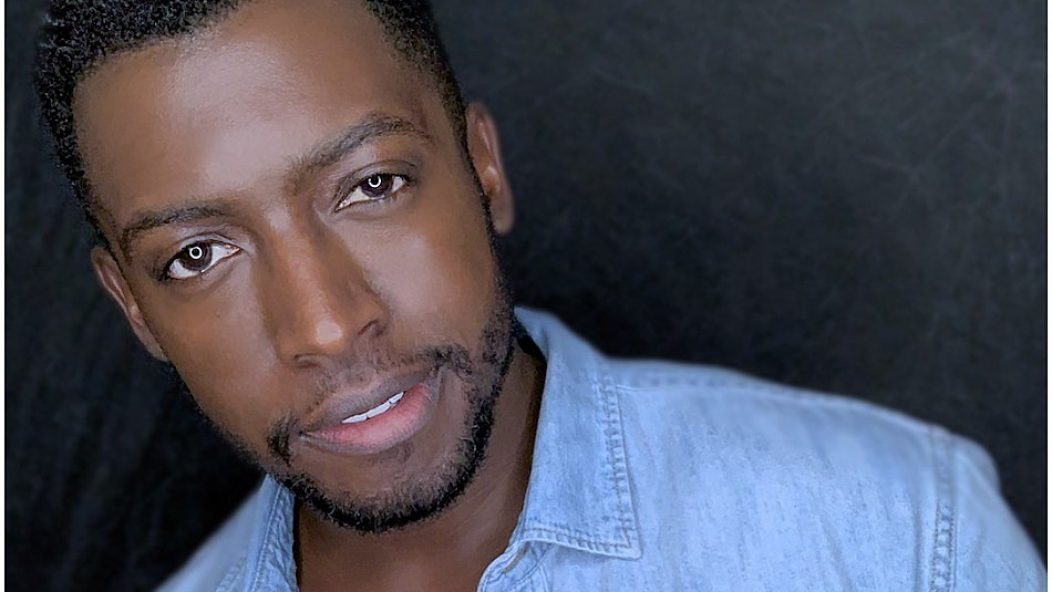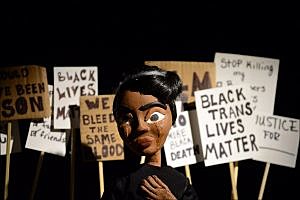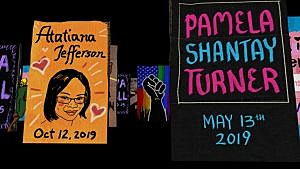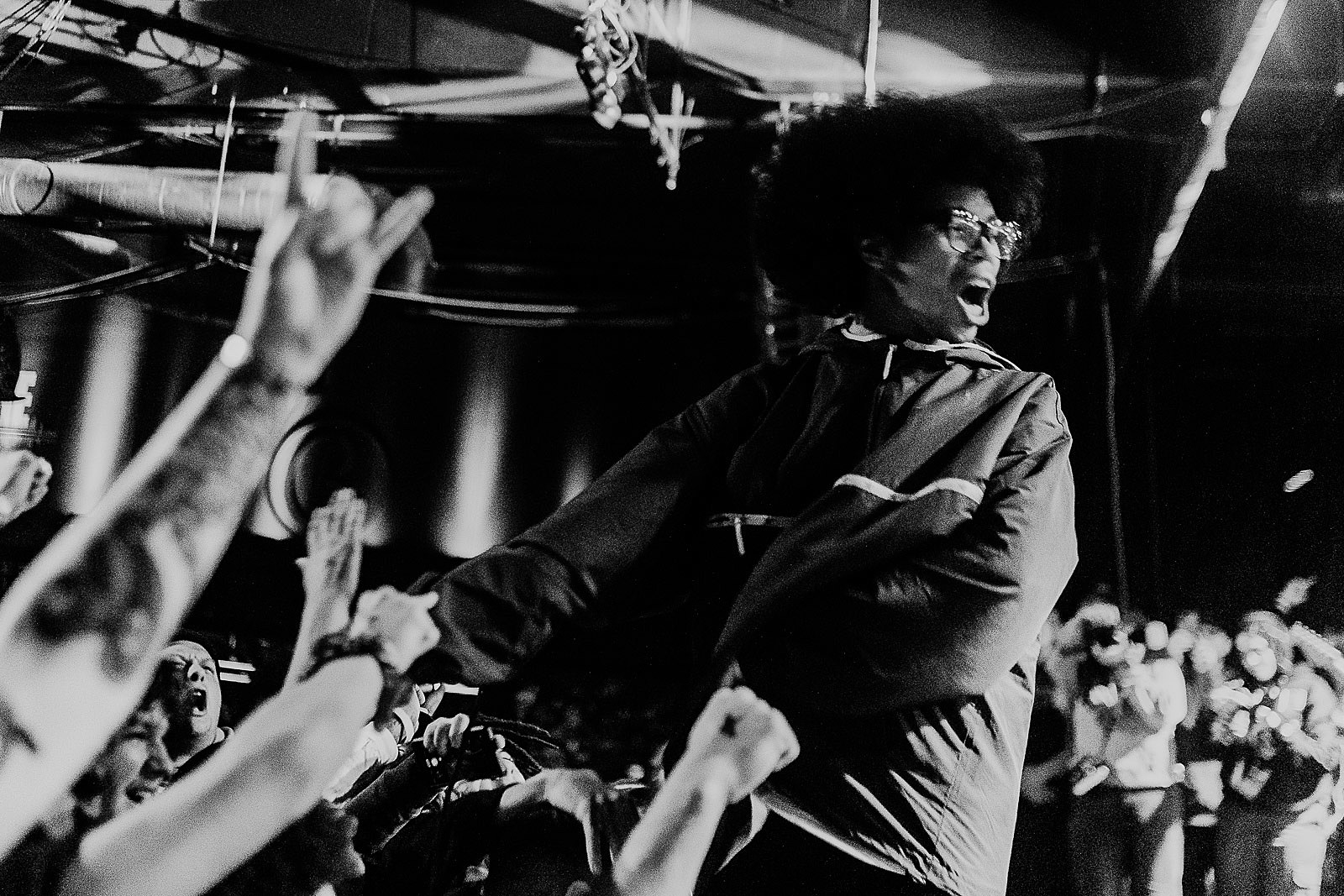
Timothy Ware-Hill deep-dives into his Netflix project ‘Cops and Robbers’
Artist and filmmaker Timothy Ware-Hill’s Cops And Robbers, an eight-minute, spoken-word, animated film that premiered in December 2020, was a pivotal moment after a devastating year. While globally we all faced the COVID-19 pandemic, the Black community continued to fight a death sentence that doesn’t exist in test tubes or lab experiments and cannot be maintained or prevented by way of a vaccination. Rather, Black communities continued to face and fight against the growing persistence of police brutality.
Highlighting childhood pureness and questioning, “You think cops remember being kids? When we used to just…play together?,” Ware-Hill and co-director Arnon Manor worked alongside one another and various designers and artists from around the world to fuse together art and awareness that would speak to people on a personal level.
Read more: FEVER 333’s Jason Aalon Butler knows the world needs more empathy
Cops And Robbers originated from a spoken-word poem that Ware-Hill wrote and posted to his social media. Offering a depiction of what it’s like to be Black in America based on the shooting and murder of 25-year-old Ahmaud Arbery in February 2020, Manor initiated the working relationship with Ware-Hill to speak on a larger platform of awareness and promote change. Despite the essence of the film only running approximately four minutes long, Cops And Robbers was praised by artists such as Jada Pinkett Smith, her daughter Willow Smith and more for its honesty and illustration of being a person of color in the U.S.
Besides the recent events in dealing with so much loss in the Black Lives Matter movement, what led you to create this short film?
I just had to say something. The video shook me to see these three white guys chasing this young Black man through the neighborhood and executing him. It shook me, but sadly, it didn’t surprise me because we’ve seen various forms of lynchings before. My form of protest has always been to write and poetry, so I dug up my poem, grabbed my iPhone, grabbed my gimbal and started jogging through the neighborhood.
How were you able to get all the artwork together? Are they all by artists you know, or were they contributions?
They were all contributions. It was a mix—some of the artists and the effects teams were organizations that Arnon Manor had worked with previously; more than 50% of our animators were Black on this project. I found most of them by going on Instagram. I searched #Blackanimators, [and] different profiles came up. I reviewed the profiles, and there was some work that moved me, and I took the next step to try to reach out to them and share with them the project that we were working on.
I would send them a link to the initial poetry video in [the] hope that the story spoke to them, and in most cases, it did. Of those animators, there were possibly two that I already had a personal connection with prior to the making of the animated film, but I created some great relationships through the project that I do have now with a variety of animators all over the world.

What response do you hope to gain from this film?
As an artist, you hope someone at least watches it because everyone is going to take from it what they take from it. That’s the beauty of art: It’s very subjective. My hope is that it keeps the ball in the air [and] it keeps people aware. The change has not been significant enough to stop the unnecessary killings and manslaughter of Black people. There’s so much more that needs to happen.
Writing for me is my form of protest, [and] creating film is my form of protest—it’s a great way to bring awareness to things. The arts have a way of shifting [the] zeitgeist in the world. It’s through the eye of [the] artist that real substantial changes happen, in my opinion. It’s not the politics or politicians; it’s art. In some big universal, out-of-body way, we have this ability to give a perspective that a lot of people might not necessarily gain on their own or through the shouts of politics and religion, but through art, that’s where we get the most significant change.

What do you believe is the main problem—the racial bias we face as African Americans, the lack of proper police training or the way the police handle their weapons?
All of the above because policing was formed to control the Black population; it came out of Reconstruction. You always have to look at the root of why things were created in the first place. It’s built on racism, so it makes sense that the racism has seeped into even just the training. Even prior to training, you have to look at how Black people are looked at, the conditioning, not just the white people, but in the way we’re taught to see ourselves; which is why we can’t rely on changing hearts to save our lives.
We have to rely on the law because you don’t have to love me or even like me for me to deserve protection. That comes before the police training. That comes with the hiring. What mental and emotional evaluations are you doing when you invite someone into the police academy? Some police join the force because they want to protect and serve, and there are some that just want to find their power.
Honestly, it’s not white police; it’s police. Yes, it’s a lot of white police, [but] it’s also Black police who are under a white system, so they’re still working under white supremacy and the things we do to try to fit in, to not rock the boat, and might go along with certain things that contradict who we are or what we believe in just to make sure we fit in. That happens in all forms of society.
With the Derek Chauvin trial, the police chief protested against Derek Chauvin, so there are good police. But those are the same people that knew his record, that gave him a job prior to this event. They knew he had put a knee on other Black mens’ necks in the past, yet now you want to speak up because the cameras caught something that forced the world to sit still for almost 10 minutes and watch. So does that make you a good cop if the only reason you speak up is because you got caught?

Have you ever experienced a racially motivated issue with the police?
Yeah, of course; more than once. I’ve been pulled over, harassed, had an officer come up to my car with his hand already on his holster. I grew up in Alabama and dealt with racism there.
I went to UCLA for graduate school, and my best friend and I had left for rehearsal with some of our white classmates in the theater program, and at that time, we would park in Westwood at the Playboy Mansion because that was the only free parking. We [left] campus with our white peers, and we were having a personal conversation as they walked a few yards ahead.
A police officer drives by the group of white kids and pulls up to ask us where we are going. We say, “We’re going to our car,” [and] he says, “Where are you coming from?” We have backpacks on. The campus is right there. We’re coming from class. Two Black guys are more of a threat than a group of white kids; there are more of them than there are of us, but you still saw us as the threat. That’s just one of quite a few incidents [where] I’ve dealt with cops.
Do you think you could use this film as a way to help explain racial profiling and police brutality to young children?
Absolutely, I think it can be. There is strong language within the film, but the language isn’t as strong as Black kids being killed by cops. Think of Tamir Rice—he was a baby. Go even further back and think about Emmett Till. I think it can be used as a tool for kids to learn. The sad reality is the talk that every Black kid gets from their parent/guardian that happens at a young age because it has to happen at a young age. So this can be a tool for little Black kids, but it can also be a tool for white kids to show this is what your peers go through, and a white kid can help use this as a tool to become an ally and help make significant change happen.
Animation is a great gateway for children as well. I think this animation is for both adults and kids. I think adults should sit with their child and watch it through; it’s important that the child has an adult that can explain what they just witnessed. What the lesson is from the film is to talk about the steps to take—if you’re a Black kid, ways to protect yourself, and if you’re a white kid, ways to be an ally for Black and Brown people.

How would you respond to critics who think your film is too graphic?
I would say that’s subjective. I would say it’s no more graphic than the videos that we’re traumatized by every month of new Black killings, and if you feel it’s too graphic, then maybe it’s not for you, and that’s fine as well.
Do you plan on making another film or series with a similar subject focus?
Yes, I do. I’m working on a feature right now called Tyrone And The Looking Glass that deals with the integration of the public school system in Birmingham, Alabama, 1963 during the height of the civil rights movement; not necessarily focusing on police violence but still dealing with racial unrest and the things we have to overcome.
I’m also working on a musical as a feature that specifically deals with police violence in the present day called The Gospel According To Coffee that deals with the Black kid that’s the preacher’s kid in Montgomery, Alabama, who after an unarmed Black man is killed by police, the community asks him to lead a peaceful protest, but he’s afraid if the community finds out he’s gay, the entire movement could fall apart.
Do all of your projects take on this form of art, or do you use other mediums?
Cops And Robbers was my first animation. My co-director Arnon Manor came from that world of animation and visual effects. I started on the stage since I went to grad school for acting. I was also writing plays and poetry. I’ve been writing my entire life, so that’s usually my way of expressing myself.
This interview appeared in issue 395, available here.








